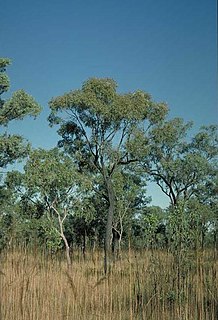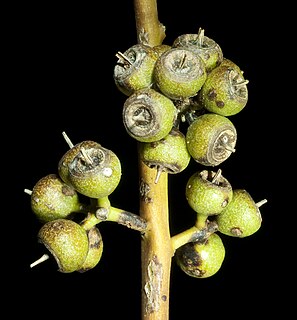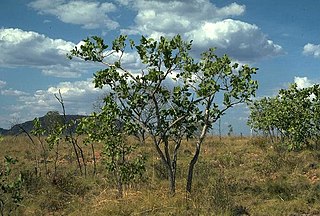Corymbia greeniana is a species of tree that is endemic to northern Australia. It has rough bark on some or all of the trunk and larger branches, smooth bark above, broadly lance-shaped to egg-shaped adult leaves, flower buds usually in groups of seven, creamy white flowers and urn-shaped fruit with a distinct neck.

Eucalyptus brachyandra, commonly known as the tropical red box, is a straggly tree, mallee or shrub and is endemic to north-western Australia. It has rough, fibrous to stringy bark on the trunk and smooth grey to white bark on the smaller branches. Mature trees have elliptic to oblong or egg-shaped leaves, tiny flower buds in groups of three or seven, creamy white flowers and cup-shaped, bell-shaped or urn-shaped fruit. It grows in the Kimberley region of Western Australia and the Top End of the Northern Territory.

Eucalyptus jensenii, commonly known as Wandi ironbark, is a species of tree that is endemic to northern Australia. It has hard, coarse black "ironbark", egg-shaped to lance-shaped adult leaves, flower buds in groups of seven, creamy white flowers and barrel-shaped to conical fruit.

Eucalyptus lucens, commonly known as the shiny-leaved mallee, is a species of mallee that is endemic to northwestern Australia. It has small, pale greyish to brown bark, glistening, lance-shaped adult leaves, flower buds in groups of seven on a branching peduncle, creamy white flowers and conical fruit.

Eucalyptus mannensis, commonly known as Mann Range mallee, is a species of mallee that is native to Western Australia, South Australian and the Northern Territory. It has rough bark at the base of the trunk, smooth bark above, narrow lance-shaped adult leaves, flower buds in groups of between seven and eleven, creamy white flowers and hemispherical fruit.

Eucalyptus oligantha, commonly known as the broad-leaved box, is a species of tree that is native to the Kimberley region of Western Australia and parts of the Northern Territory. It has rough, fibrous or flaky greyish bark, broadly egg-shaped to almost round adult leaves that are lost in the dry season, flower buds in groups of three or seven, creamy yellow to whitish flowers and cup-shaped to more or less cylindrical, bell-shaped or conical fruit.
Eucalyptus ordiana is a species of small tree or a mallee that is endemic to the Kimberley area of Western Australia. It has smooth, powdery bark, egg-shaped leaves, flower buds in groups of seven, white flowers and cup-shaped fruit.

Eucalyptus petrensis, commonly known as limestone mallee, straggly mallee or koodjat, is a species of straggly mallee that is endemic to Western Australia. It has mostly smooth bark, lance-shaped adult leaves, flower buds in groups of between seven and thirteen, creamy white flowers and more or less spherical fruit.

Corymbia abbreviata, also known as the scraggy bloodwood, is a species of straggly tree that is native to Western Australia and the Northern Territory. It has rough bark, a crown of stiff leaves arranged in opposite pairs, flower buds usually in crowded groups on the ends of branchlets and urn-shaped fruit.

Corymbia bleeseri, commonly known as the glossy-leaved bloodwood or the smooth-stemmed bloodwood, is a species of tree that is endemic to northern Australia. It has thin, rough bark on part or all of the trunk, smooth bark above, lance-shaped to curved adult leaves, flower buds in groups of seven, creamy white flowers and barrel-shaped fruit.

Corymbia confertiflora, commonly known as the broad-leaved carbeen or the rough leaf cabbage gum, is a species of tree that is endemic to northern Australia. It has rough, tessellated bark near the base of the trunk, smooth white to pale grey bark above, a crown of both intermediate and adult leaves, large numbers of flower buds borne on leafless sections of branchlets in groups of seven, creamy white flowers and cylindrical to barrel-shaped or bell-shaped fruit.
Corymbia deserticola is a species of straggly tree, a mallee or a shrub that is native to Western Australia and the Northern Territory. It has rough, tessellated bark on the trunk and branches, mostly sessile, heart-shaped leaves arranged in opposite pairs, flower buds in groups of seven on each branch of a peduncle, creamy yellow flowers and urn-shaped to shortened spherical fruit.

Corymbia erythrophloia, commonly known as the red bloodwood, variable-barked bloodwood, red-barked bloodwood or gum-topped bloodwood, is a species of tree that is endemic to Queensland. It has rough bark on the trunk and branches, egg-shaped or lance-shaped adult leaves, flower buds in groups of seven, creamy white flowers and urn-shaped to spherical fruit.

Corymbia ferriticola, commonly known as the Pilbara ghost gum, is a species of tree or a mallee that is endemic to Western Australia. It has smooth bark, lance-shaped adult leaves, flower buds in groups of seven, creamy white flowers and shortened spherical to cylindrical fruit.

Corymbia ferruginea, commonly known as the rusty bloodwood, is a species of tree that is endemic to northern Australia. It has rough, tessellated bark on the trunk and branches, a crown of sessile juvenile leaves, flower buds in groups of three or seven, pale creamy yellow flowers and urn-shaped fruit.

Corymbia foelscheana, commonly known as the broad-leaved bloodwood, fan-leaved bloodwood or smooth-barked bloodwood, is a species of small tree that is endemic to northern Australia. It has thin, rough, tessellated bark on some or all of the trunk, smooth bark above, broadly egg-shaped to broadly lance- shaped adult leaves, flower buds usually in groups of seven, creamy white flowers and urn-shaped fruit.

Corymbia kombolgiensis, commonly known as the scarp gum or the paper-fruited bloodwood, is a species of small tree that is endemic to the Northern Territory. It has smooth bark, sometimes with rough, tessellated bark near the base, linear to narrow lance-shaped adult leaves, flower buds usually in groups of seven, white flowers and cylindrical to barrel-shaped fruit.

Corymbia latifolia, commonly known as the round-leaved bloodwood, round leaf bloodwood, wubam and other names in indigenous languages, is a species of tree that is endemic to northern Australia. It has thin, rough bark over part or all of the trunk, smooth bark above, triangular or broadly egg-shaped adult leaves, flower buds in groups of seven, creamy white flowers and urn-shaped fruit.

Corymbia nesophila, commonly known as the Melville Island bloodwood, is a species of tree that is endemic to northern Australia. It has rough, tessellated bark on the trunk and branches, lance-shaped or curved adult leaves, flower buds in groups of seven, creamy white flowers and urn-shaped fruit.

Eucalyptus distans, commonly known as the Katherine box, is a species of small tree that is endemic to northern parts of Australia. It has rough, fibrous grey bark, dull, narrow lance-shaped adult leaves, flower buds in groups of seven, creamy white flowers and cup-shaped to hemispherical or conical fruit.

















